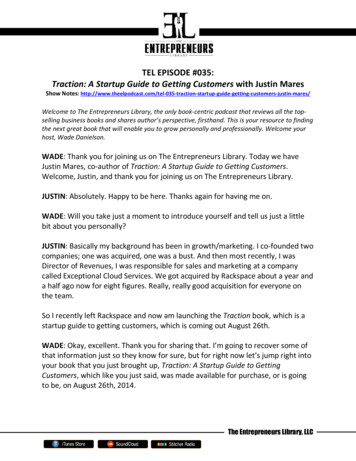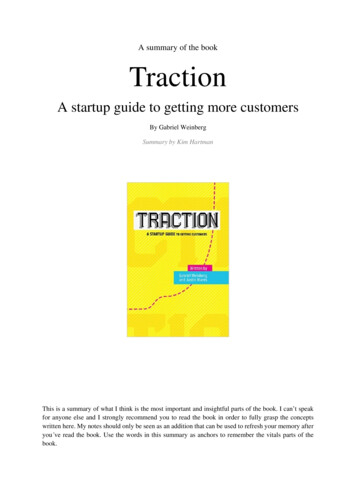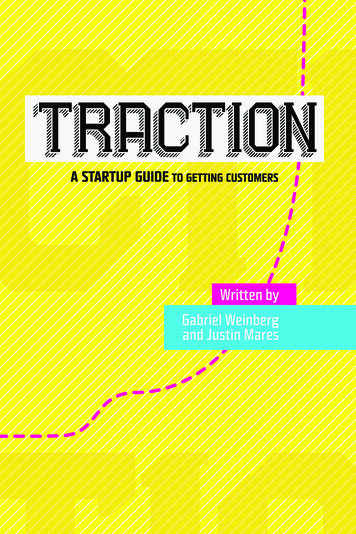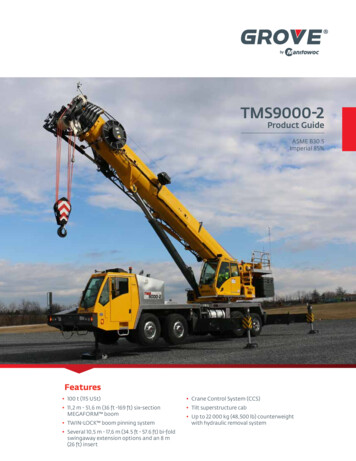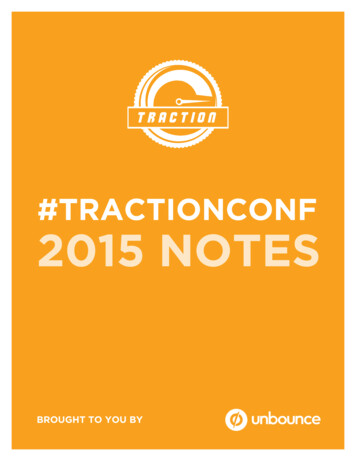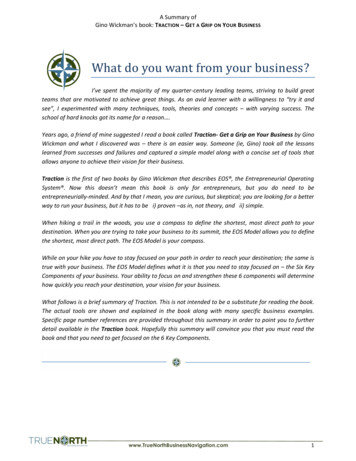
Transcription
A Summary ofGino Wickman’s book: TRACTION – GET A GRIP ON YOUR BUSINESSWhat do you want from your business?I’ve spent the majority of my quarter-century leading teams, striving to build greatteams that are motivated to achieve great things. As an avid learner with a willingness to “try it andsee”, I experimented with many techniques, tools, theories and concepts – with varying success. Theschool of hard knocks got its name for a reason .Years ago, a friend of mine suggested I read a book called Traction- Get a Grip on Your Business by GinoWickman and what I discovered was – there is an easier way. Someone (ie, Gino) took all the lessonslearned from successes and failures and captured a simple model along with a concise set of tools thatallows anyone to achieve their vision for their business.Traction is the first of two books by Gino Wickman that describes EOS , the Entrepreneurial OperatingSystem . Now this doesn’t mean this book is only for entrepreneurs, but you do need to beentrepreneurially-minded. And by that I mean, you are curious, but skeptical; you are looking for a betterway to run your business, but it has to be i) proven –as in, not theory, and ii) simple.When hiking a trail in the woods, you use a compass to define the shortest, most direct path to yourdestination. When you are trying to take your business to its summit, the EOS Model allows you to definethe shortest, most direct path. The EOS Model is your compass.While on your hike you have to stay focused on your path in order to reach your destination; the same istrue with your business. The EOS Model defines what it is that you need to stay focused on – the Six KeyComponents of your business. Your ability to focus on and strengthen these 6 components will determinehow quickly you reach your destination, your vision for your business.What follows is a brief summary of Traction. This is not intended to be a substitute for reading the book.The actual tools are shown and explained in the book along with many specific business examples.Specific page number references are provided throughout this summary in order to point you to furtherdetail available in the Traction book. Hopefully this summary will convince you that you must read thebook and that you need to get focused on the 6 Key Components.www.TrueNorthBusinessNavigation.com1
A Summary ofGino Wickman’s book: TRACTION – GET A GRIP ON YOUR BUSINESSIntroductionIt starts with the 5 Frustrations –most (but not all) business owners are experiencing one or more of these:1. Control, as in the Lack of: Whether it’s control over your time, your market, or your company. You’re notcontrolling your business – it’s controlling you instread.2. People: You’re frustrated with your employees, business partners, vendors, or customers. They don’t listen,don’t understand, or don’t follow through. You’re not on the same page.3. Profit: Or more simply, there’s not enough of it.4. The Ceiling: Your growth has stopped, you can’t seem to break through to the next level and you’re notsure what to do next.5. Nothing’s Working: You’ve tried one or more strategies, read all the books, the flavor-of-the-month justisn’t working.What Gino figured out was, most business leaders, owners, entrepreneurs, tend to wrestle with 136 thingssimultaneously. That’s just business - there’s a lot going on in business. The irony is the business owners thatweren’t frustrated were only focused on 6 things and to the degree you can focus on these six things and strengthenthese six key components, the 136 things have a miraculous way of falling into place.The 6 Key ComponentsThe 1st Key Component is the Vision component. And strengthening this component means getting everyone in theorganization 100 percent on the same page with where you’re going and how you’re going to get there.The 2nd Key Component is the People component. Simply put, you can’t do it without great people. Thismeans surrounding yourself with great people, top to bottom, because you can’t achieve a great vision without greatpeople.The 3rd Key Component is the Data component. This means cutting through all the feelings, personalities, opinionsand egos and boiling your organization down to a handful of objective numbers that give you an absolute pulse onwhere things are.www.TrueNorthBusinessNavigation.com2
A Summary ofGino Wickman’s book: TRACTION – GET A GRIP ON YOUR BUSINESSWith the Vision component strong, the People component strong and the Data component strong, you start to createa lucid, transparent, open and honest organization where everything becomes more visible and you start to “smokeout all the issues”, which leads to the 4th Key component.The 4th Key Component is the Issues component. Strengthening this component means becoming great at solvingproblems throughout the organization – your ability to become great at this will be directly proportional to yoursuccess.The 5th Key Component is the Process component. This is the secret ingredient in your organization. This means“systemizing” your business by identifying and documenting the core processes that define your way to run yourbusiness – getting everyone on the same page with what the essential procedural steps are in your core processesand then getting everyone to follow them so you create consistency and scalability in your organization.The 6th and final Key Component is the Traction component. This means bringing discipline and accountability intothe organization – becoming great at execution – taking the vision down to the ground and making it real.To the degree you focus on strengthening these components as leaders and managers, everything else will fall intoplace. And by strengthening these components you can move your business from its current state of performance,on average 30-35% effective, into the top 5 percent. Complete the Organizational Checkup on pages 10-11 oronline at www.TrueNorthBusinessNavigation.com/orgcheckup and see where your business is today.Now, there are literally hundreds of ways to strengthen the Six Key Components of your business and thousands ofbooks that provide instruction for strengthening aspects of each component. So you can do this – you canstrengthen your business and catapult it into the top 5 percent.SUCCESSFUL COMPANIES OPERATE WITH A CRYSTAL CLEAR VISION THAT IS SHARED BY EVERYONE. THEYHAVE THE RIGHT PEOPLE IN THE RIGHT SEATS. THEY HAVE A PULSE ON THEIR OPERATIONS BY WATCHINGAND MANAGING A HANDFUL OF NUMBERS ON A WEEKLY BASIS. THEY IDENTIFY AND SOLVE ISSUESPROMPTLY IN AN OPEN AND HONEST ENVIRONMENT. THEY ESTABLISH PRIORITIES FOR EACH EMPLOYEE ANDENSURE THAT A HIGH LEVEL OF TRUST, COMMUNICATION, AND ACCOUNTABILITY EXISTS ON THE TEAM.Letting Go of the VineIf you are not happy with the current state of your company, you have 3 choices: Live with it, Leave it, or Change it. Ifyou‘re choosing one or two, then you are wasting your time reading these books. But if you are taking the 3rd choice,then you have to be willing to – let go of the vine.In order to let go, you must embrace four fundamental beliefs:1.2.3.4.You must build and maintain a true leadership teamHitting the ceiling is inevitableYou can only run your business on one operating systemYou must be open-minded, growth-oriented and vulnerable.www.TrueNorthBusinessNavigation.com3
A Summary ofGino Wickman’s book: TRACTION – GET A GRIP ON YOUR BUSINESSBuilding a True Leadership TeamFirst you must choose between a dictatorship and a healthy leadership team. Assuming you choose a leadershipteam, them they along with you are responsible for defining the company’s vision. Each leader must have clearaccountabilities and must take initiative over their department. As a team, you must be open and honest about allissues and willing to work for the greater good. Then, as goes the leadership team, so goes the company. Your teammust present a united front to the rest of company.Hitting the CeilingOrganizations, like kids, grow in fits and spurts breaking through one ceiling after another. Unlike kids, organizationsmust learn techniques that will allow them to continue to grow. The leadership team must master five leadershipabilities to continue to reach the next level. These are further detailed on pages 18 - 23.1.2.3.4.5.Simplify the organization.Delegate and elevate.Predict both short-term and long-term.Systemize.Structure your company the right way.You can only run your Business on one Operating SystemJust like your laptop or your phone, you can only run on one operating system. You must have one approach that youand your leadership team use to establish how you meet, how you set priorities, how you plan and how you set yourvision. This will also define the terminology or language by which you will communicate with the employees. And justlike Android, IOS, or Windows does this for your hardware, EOS does this for your business.You must be Open-Minded, Growth-Oriented, and VulnerableIf you’re not willing to listen and try something new; if you won’t admit when you don’t know something; if you’re notwilling to ask for help – EOS is not for you. However if you know your strengths and weaknesses and you’ll let otherpeople, who may be more skilled than you in certain areas, take charge – then keep reading.But don’t start down this path if you can’t be vulnerable – let your guard down, look at your business objectively, fromoutside of the organization, rather than from within it. Be warned - creating a healthy, open and honest leadershipteam can be a rude, eye-opening experience.If you are willing to embrace these four beliefs, you are ready to let go of the vine. The next step is to figure out justhow to go about strengthening these 6 Key Components. Just like most long and challenging hikes, you can spendweeks or months trying to map and then follow your route. Or, you can learn from others who have successfullymade the trip already. EOS is based on years of working with leaders and managers, with over 10,000 hours ofhoning and refining and perfecting the best two tools to strengthen each of the 6 Key Components.www.TrueNorthBusinessNavigation.com4
A Summary ofGino Wickman’s book: TRACTION – GET A GRIP ON YOUR BUSINESSThe ToolsIt’s important to understand something about these tools, none of this is theory. There are over 5000 companiesinteracting with these tools. They’ve been tested and proven hundreds of times. It’s simple, and it works.Vision: The 8 Questions (V/TO)The first discipline in the Vision component is simply called The 8 Questions. These 8questions, when answered and agreed to by the leadership team, allow you to capture anddefine the Vision of your company. The tool for capturing the answers is called the V/TO –Vision Traction Organizer (see page 32). The questions are:1.2.3.4.5.6.7.8.Core Values?Core Focus?10-Year Target?Marketing Strategy?3 Year Picture?1 Year Plan?Quarterly Rocks?Issues?What are your Core Values? Core values got a bad rep back in the ‘80’s when the majority ofcompanies thought implementation was primarily having the executive announce what theyare followed by giving out printed cards for you to stick on your bulletin board. But the realityis, Core Values define you culture – they exist today whether you have captured them or not.When they are clear, they will attract like-minded people to your organization. When they areapplied to your existing organization, they will weed people out that don’t fit. Once captured,they must be used for hiring, firing, review, rewards and recognition. This is how you keepthem alive. Pages 34 – 37 teaches you how to discover what yours are.What is your Core Focus? It comes from your core and to thrive, you must stay laserfocused on it. Your leadership team needs to establish what your organization’s core focus isand then not let anything distract you from it. To learn how to find yours see pages 48 – 52.What is your 10-Year Target? Some leadership teams are more comfortable with 5 years,some with 30 years, some just call it their BHAG (big hairy audacious goal) and any one isfine. The question is the same – now that your core values and core focus are clear, what’syour long-term target? Keep your answer short & simple - just a couple sentences.What is your Marketing Strategy? The goal of your marketing strategy is to get you laserfocused on your sales and marketing efforts – and it’s really quite simple, just four elements:1.2.3.4.Your Target Market / “The List”Your Three UniquesYour Proven ProcessYour GuaranteeYour Target Market: Who is your ideal customer? (And if you say everyone, you losepoints.) Your ideal customer can be described by identifying their demographic, theirwww.TrueNorthBusinessNavigation.com5
A Summary ofGino Wickman’s book: TRACTION – GET A GRIP ON YOUR BUSINESSgeographic and their psychographic – Who are they? Where are they? And how do theythink? The more specific you can be, the better your chances are of doing business withthem. Pages 63 – 65 show you how to build your “List” of ideal customers.Your Three Uniques: Unless you want to compete solely on price, you need todifferentiate your business from your competitors. You need to stand out. You might shareone or two of your uniques with a competitor, but no one else should be able to claim allthree. Then commit to them – make sure your sales and marketing efforts reflect whatmakes you unique. And stay true to them; don’t try to be all things to all people. Figure outhow to choose yours, see pages 56 - 57.Your Proven Process: A one page, full-color visual of the proven way you take care ofyour customer. You’re not making it up as you go; it’s what got you to where you’re attoday. It’s the way you interact with every customer, it’s proven, and it works. It’s a verypowerful tool for helping your potential customers feel comfortable with you. Give it aname – it’s the (your company name) Difference! Use it instead of inundating potentialcustomers with long sales presentations. Create yours by following the instructions onpages 60 – 62.Your Guarantee: Think Federal Express (guaranteed overnight); Think Dominos (30 mindelivery or free); I actually saw a billboard on the interstate for a local ER with a real-timedisplay of their current wait time! It’s your chance to pinpoint an industry-wide problemand solve it. What is it that customers can count on from you? If you guarantee it, you’llput their minds to rest and close more business. As a side benefit, it forces yourorganization to deliver on it. That in turn will force you to look internally and make sureyou have the people, processes and systems in place to deliver on it. How to select yoursis on pages 58 – 59.What is your 3-Year Picture? Everyone knows in today’s world that there’s little value in astrategic plan that goes beyond 3 years, but having no plan at all is just as crazy. The goal here isjust to paint a picture, 5 – 15 bullets of what you see when you close your eyes and imagine 3years from now. This simple exercise greatly enhances your ability to define a one year plan –what do you need to do in the next year to get you 1/3 of the way towards your 3 year picture. Paintyour 3-Year Picture using pages 65 – 68.What is your 1-Year Plan? Now you move from the Vision-side of the V/TO document to theTraction-side (see the V/TO on page 32). What are the 3 – 7 most important things you must getdone this year? Not the 37 things, the 3 – 7 (less is more). The EOS approach forces you to focuson the few versus the many. And the reality is, by doing this you will accomplish more! Create your1-Year plan, see pages 68-69.What are your Quarterly Rocks? Now that you have a clear 1-Year plan, you must narrow yourfocus to what really matters – the next 90 days. The term Rocks is from Stephen Covey’s analogywith time management, it’s just another word for goal, priority, or objective. Quarterly Rocks are themost important things (again 3 - 7) you need to get done this quarter. This is where the Tractioncomes from; creating a pulse whereby every 90 days your leadership team comes together andsets its priorities for the next quarter based on the one-year plan which in turn keeps you on trackfor the three-year picture.www.TrueNorthBusinessNavigation.com6
A Summary ofGino Wickman’s book: TRACTION – GET A GRIP ON YOUR BUSINESSWhat are your Issues? While including a list of issues may seem like a strange thing to includewith your Vision, it’s actually a very important and natural aspect. Once you have figured out whereyou want your business to go, it’s natural to have thought of the obstacles or barriers that arestanding in your way. Well, write them down and then solve them. An open an honest leadershipteam must be very comfortable calling out the issues and your ability to solve them is directlyproportional to your ability to succeed. See pages 70-71 for a technique on how solve issues.Vision: Shared by AllNow that you and your leadership team have answered the 8 Questions and captured them in theV/TO, you are ready for the second discipline of the Vision component. It is known as SBA orShared By All. This is easier said than done, but here are three events you can use to effectivelycommunicate your vision:1. Have an initial meeting with the organization and share your clearly defined vision – showthe V/TO.2. Every 90 days, have a (short) state of the business meeting. Share the results of yourprogress on last quarter’s rocks and the new rocks for next quarter. Share the V/TO anduse the opportunity to revisit and remind of the other aspects of your vision.3. Shortly following the state of the business review, meet with each department and setrocks for the department.Having everyone in the organization lined up and rowing the same direction is a very powerfulapproach to achieving your potential as an organization and to achieving your Vision.People: Right People (People Analyzer)Having a great vision will get you nowhere without great people. The challenge is, how do youidentify the right people? The right people are simply the ones that share your core values. Theynot only fit in your culture, they thrive in it. Jim Collin’s popularized the term, “right people, rightseats” in his book, Good to Great. But defining how you actually do this was not covered.This is where the second EOS tool gets introduced – the People Analyzer. Using your core valuesplay the People Analyzer will tell you whether you have the Right People.Core Values People Analyzer Right PeopleOne of the most difficult situations to deal with is when someone is great at their job, but doesn’tshare your core values - this is known as Wrong Person / Right Seat. The reality is this person iskilling your company from the inside much like a cancer. The sooner you can recognize this andresolve it, the better off you will be and your other employees will thank you. To discover how easythis tool is to use and what to do when you have a right-people issue, see pages 84 - 87.People: Right Seats (Accountability Chart)The second discipline in the People component is to make sure everyone is the Right Seat – thatthey are operating in a seat where their greatest skill and passion are being tapped. Dan Sullivancalls this their “Unique Ability”. When a person is operating in his/her Unique Ability, they are in theright seat. One of the obstacles in gaining traction and achieving your vision is that the roles andwww.TrueNorthBusinessNavigation.com7
A Summary ofGino Wickman’s book: TRACTION – GET A GRIP ON YOUR BUSINESSresponsibilities, the expectations are unclear due to structural issues. So you must look at this froma structure first / people second perspective.In order to determine the best and simplest structure, you must first fire everyone in yourorganization (at least virtually). Because one of the most common mistakes is creating a structureto accommodate people you like or don’t want to lose. A seat cannot be created until theorganization is structured in the right way to lift your company to the next level. This is where thethird EOS tool gets introduced; to create that structure you’ll use the Accountability Chart. It’s theultimate tool for structuring your organization the right way, with every seat having clearly definedroles and responsibilities.Unique Ability Accountability Chart Right SeatThere are hundreds of books on organizational development, the question is: What is the rightstructure to move your organization forward in the next 12 months? The Accountability Chart,second only to the VT/O, has the most impact of any EOS tool. Learn how to build yours on pages88 - 110.Data: ScorecardWith your vision clear and shared by all and with the right people and right seats, you now need tobe able to measure your progress – you need an absolute pulse on your business. You can’t relyon assumptions or opinions, you need a handful of carefully chosen numbers that you can use tomanage your business on a weekly basis and quickly determine what’s on-track and off-track.The concept of Scorecard is not new, the unfortunately reality is that most organizations don’t haveone. You can’t manage what you can’t measure. Your scorecard should contain 5 - 15 activitybased numbers, what the target or goal is, and clearly identifies who owns each number. Then,when the leadership team goes through their weekly review, whether or not it’s on-track and who isaccountable is (painfully) obvious.You should also track a rolling 13-week history for each number in order to establish the patternsand trends. Ultimately giving you the ability to predict what’s going to happen and therefore beproactive instead of reactive. How to create your scorecard and example metrics can be found onpages 116 - 122.Data: MeasurablesWhat gets measured gets done. Now that the leadership team is using a scorecard to track overallcompany progress towards the vision, how is everyone else in the company contributing towardsthis path? Each department should have their own scorecard with 3 – 5 numbers and/or everyperson in the organization has a number. This way everyone in the company can see how they arecontributing to the greater good.There are eight distinct advantages to everyone having a number:1. Numbers cut through murky subjective communication between manager and directreports. They become a communication tool between manager and direct reports,creating the basis of comparison, unemotional dialogue and results.www.TrueNorthBusinessNavigation.com8
A Summary ofGino Wickman’s book: TRACTION – GET A GRIP ON YOUR BUSINESS2. Numbers create accountability. When you set a number, everyone knows what theexpectation is. Accountability begins with clear expectations and nothing is clearer than anumber.3. Accountability people appreciate numbers. Wrong people in the wrong seats usuallyresist measurables. Right people in the right seats love clarity. Knowing the numbersthey need to hit, they enjoy being part of a culture where all are held accountable.4. Numbers create clarity and commitment. When an employee is clear on his or hernumber and agrees that he or she can achieve it, you have commitment. There is no grayarea.5. Numbers create competition. There’s nothing wrong with a little pressure.6. Numbers produce results. What gets watched improves.7. Numbers create teamwork. When a team composed of the right people in the right seatsagree to a number to hit, they ask themselves “how can we hit it,” creating camaraderieand peer pressure.8. You solve problems faster. When an activity-based number is off track, you can attack itand solve the problem proactively; unlike with an end-result based number that shows upafter it’s too late to change it. In addition, the use of hard data cuts through all of thesubjective and emotional opinions that create murkiness and lengthen the amount of timeit takes to make the right decision.Issues: ListNow stop and think for a moment what your organization looks like – your vision is clear, you haveall the people in place, and you have an absolute pulse on the business. As a result you have avery open and honest, transparent organization. What now becomes obvious is – the issues inyour way of achieving your vision.In order to succeed you need the discipline to face these issues and solve them. It’s human natureto shy away from issues, a reluctance to take action – but your ability to succeed is directlyproportional to your ability solve problems. This leads to the first discipline of the Issues component– the List. Creating the organizational habit (comfort, if you will) to identify and build a list of theissues in your way. You should compartmentalize the issues into three Lists:1. The Issues List in your Vision/Traction Organizer (V/TO): These are the companyissues that can be shelved beyond 90 days. These issues are tackled in future quarterlymeetings. The issues that are not big enough priority for this week or this quarter must bestored somewhere so that you don’t lose sight of them. The V/TO Issues List is the placefor that. This list will include issues as diverse as new product ideas, key employeeissues, technology needs, office relocation, capital needs and the need for HR policies.They’ll go there if this is not the quarter to solve them because you have bigger fish to fry.2. The weekly leadership team Issues List: The time frame on these items is muchshorter. These are all of the relevant issues for this week and quarter that must betackled at the highest level. These issues will be resolved in your weekly leadership teammeetings. You should not be solving departmental issues. These will typically be morestrategic in nature. If it can be solved at a departmental level, push it down. Leadershipissues include things as diverse as company Rocks being off track, a bad number in thewww.TrueNorthBusinessNavigation.com9
A Summary ofGino Wickman’s book: TRACTION – GET A GRIP ON YOUR BUSINESSScorecard, key employee issues, major client difficulties and process and system relatedproblems.3. The departmental Issues List: These issues are on a more local level. These includeall the relevant departmental issues for the week that must be tackled during the weeklydepartmental meetings. The sales team might have hitting call numbers, presentations,closing business and marketing and presentation materials on their list, while theoperations team might have fulfilling orders, purchasing, customer complaints and lowproduction numbers on theirs.With an open and honest culture the three Issues Lists should start being populated. Each issuearising having a place (a list) to live on, you now need a discipline to solve them.Issues: IDSWhen it comes to teams actually solving issues, they struggle for a variety of reasons: fear ofconflict, lack of focus, lack of discipline, lack of commitment and personal ego. These reasons canbe overcome by following a very simple discipline to resolve your issues, it’s the Issue-SolvingTrack and it’s called IDS. IDS stands for these three simple steps:1. Identify2. Discuss3. SolveThis approach was created after watching team after team get in to a room to work on their issuesand the whole time would be spent discussing, and discussing, and discussing – rarely did theyidentify the issue and even more rarely did they solve anything.Step 1: Identify: Cleary identify the real issue. What’s often first stated as the issue is rarely thetrue issue, more likely it’s a symptom. You must spend the time to dig and uncover the true issue.Extra time spent on this step will be saved twice-over on the next two steps.Step 2: Discuss: Most teams spend the majority of their time here. They’ve skipped the work toget to the true issue and are more comfortable just discussing the heck out of an issue. In thepurest form, the discussion step gives everyone a chance to have their say about the issue - butjust once! Just once around the table to get everyone’s view on the table. Now that everything is inthe open- options, ideas, solutions, data and concerns – you can move on to the last step.Step 3: Solve: Most of the time the solve step is the easiest. If you have done a good job at steps1 and 2, the solution will be obvious 95% of the time. Now just turn the solution into a clearlydefined action assigned to one person – a To Do.These solutions will generally take one of three forms. The first and most typical, there’s an actionrequired and the To Do is assigned to someone to take this action. The second form is when thesolution just requires an increased awareness. There may be a To Do to ensure all the necessaryparties are made aware. The third is when the issue needs more research or data and the To Do isassigned to someone to gather this additional information.For some great advice on how to solve issues, read the 10 Commandments of Solving Issues onpages 141 – 144.www.TrueNorthBusinessNavigation.com10
A Summary ofGino Wickman’s book: TRACTION – GET A GRIP ON YOUR BUSINESSProcess: DocumentNothing can be scaled until it’s repeatable. Nothing can be replicated until it’s consistent. In orderto break through the ceiling and build a well-oiled machine, you need to possess the ability tosystemize. In many companies, people do their jobs however they want – resulting in tremendousinefficiencies and inconsistencies becoming embedded in their unique business model.The Process component strengthens your business by documenting the 6 – 10 core processes thatmake up your unique way of doing business. In capturing these core processes, EOS employs thePareto principal – document the 20% that produces 80% of the results. Until you do this, yourbusiness is running you.Just agree on what your high level, handful of core processes are as a leadership team and getthem documented. These are things like your people process. Every organization has a peopleprocess. It’s how you find them, recruit them, hire them, orient them, manage them, and fire them.A marketing process—every business has a ma
A Summary of Gino Wickman’s book: TRACTION – GET A GRIP ON YOUR BUSINESS www.TrueNorthBusinessNavigation.com 1 What do you want from your business? I’ve spent the majority of my quarter-century leading teams, striving to build great teams that are motivated to achieve great things.File Size: 1MB
